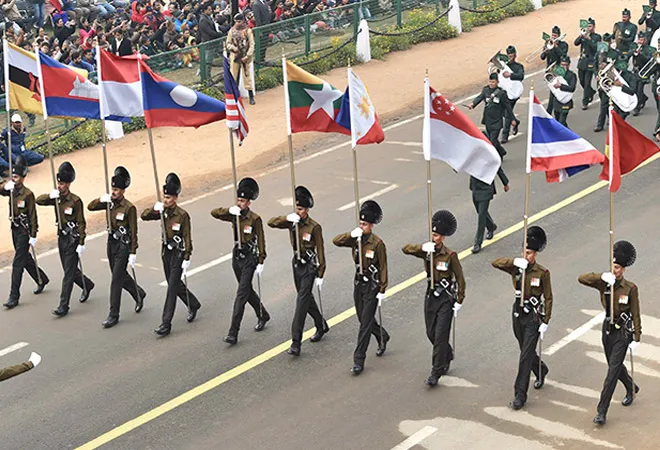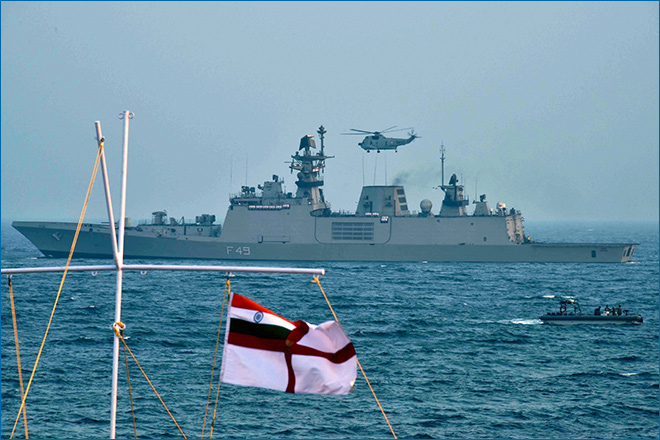
At its 69th Republic Day celebrations on Friday, India is hosting leaders from the Association of Southeast Asian Nations (ASEAN). In what is being
described as the “most significant exposition of New Delhi’s ‘Act East policy’, the heads of government of all 10 ASEAN nations will be attending the Republic Day parade, the first time so many leaders will together be chief guests at the event which showcases India's military might.
New Delhi has also organised the ASEAN-India Commemorative Summit on 25 January, which reports suggest is likely to focus on connectivity and maritime issues in the Asia Pacific region. Speaking at an event in Singapore last week, External Affairs Minister Sushma Swaraj had
flagged the importance of connectivity in the India-ASEAN relationship. Singling out the trilateral highway project from India to Thailand for special mention, Swaraj underscored the need for her country to extend its connection further with other ASEAN countries, hastening regional development. The commemorative summit comes days after Ms. Swaraj returned from a three-nation trip to Southeast Asia where she is said to have taken stock of connectivity projects between India and the ASEAN region.
But ASEAN member states aren’t particularly enthused by India’s eastwards push. At a recent conference of the Council for Security Cooperation in the Asia-Pacific (CSCAP) held in Thailand, a delegate from Southeast Asia
remarked that India was “not performing” in the Asia Pacific. While New Delhi had rechristened its ‘Look East’ policy as ‘Act East’, he remarked, many in Southeast Asia felt India was simply “at ease”.
There is a sense that while ASEAN agrees with India’s emphasis on regional integration and infrastructure creation, it would like to see a more robust Indian naval posture in Southeast Asia. While this may not take the shape of joint patrols in the South China Sea, greater participation by the Indian navy in multilateral maritime exercises and expanded ‘presence operations’ in the wider Asia Pacific littorals would certainly be a welcome development. To be sure, the Indian Navy has raised the frequency of its eastern deployments, exercising with regional navies in the wider Indo-Pacific region. India’s Pacific forays, however, have lacked the vigor of its Indian Ocean initiatives.
There is a sense that while ASEAN agrees with India’s emphasis on regional integration and infrastructure creation, it would like to see a more robust Indian naval posture in Southeast Asia.
That India and ASEAN differ in their perspectives on maritime security is clear from the latter’s opposition to the idea of the Indo-Pacific — a concept many Southeast Asian analysts believe was fashioned with the sole intension of including India within the strategic confines of the Asia-Pacific. The excessive focus on India in the Indo-Pacific, they aver, has diluted the focus on ASEAN in maritime security discussions in East Asian forums such as the ASEAN Regional Forum and the East Asia Summit. For many, New Delhi hasn’t really expanded its security aid and maritime exercises in Southeast Asia. The modest credit line for procurement of basic military equipment, and the offer for training for submarine crew and fighter pilots, hasn’t rendered India a strategic player in the affairs of the Pacific.
 Source: PTI
Source: PTI
Indeed, one could make the case that New Delhi has been indifferent to the politics of the South China Sea. In recent days, China has moved to
militarise reclaimed features in the Spratly and Paracel chain of islands in the South China Sea. Beijing has built aircraft hangers, ammunitions storages, military bunkers, and radar stations on its fortified islands. Beijing has even deployed J-11 fighter aircraft on Woody Island in the Paracels. But beyond rhetorical solidarity on the issue of freedom and navigation and overflight (and an agreement with Singapore for maritime logistics), India has done little to expand its military support to smaller Southeast Asian states.
Naturally, ASEAN states are keen to know if India is willing to take a stronger stand on maritime security in the South China Sea. While New Delhi has often spoken in favour of freedom of navigation and over-flight, and the peaceful resolution of conflicts in the South China Sea, it has desisted from actively criticising Beijing for its aggressive tactics in the regional littorals. Indian policymakers have chosen to focus on the PLAN’s assertive forays in South Asia, raising concern about growing Chinese submarine and naval deployments in Sri Lanka and Pakistan. New Delhi has also been vocal about China’s growing military influence in the Indian Ocean Region (IOR), particularly its efforts to build dual use commercial-military facilities in the Western Indian Ocean littorals. When it comes to China’s activities to the East of Malacca straits, however, New Delhi’s reactions have been conspicuously muted.
While New Delhi has often spoken in favour of freedom of navigation and over-flight, and the peaceful resolution of conflicts in the South China Sea, it has desisted from actively criticising Beijing for its aggressive tactics in the regional littorals.
New Delhi’s dilemma vis-à-vis ASEAN is that the latter stands divided on issues of maritime security. A subgroup within the organisation supports China and its policy of bilateral dialogue with disputants in the South China Sea. While states like Cambodia and Laos support Beijing in its efforts to manipulate the Code of Conduct discussion in Southeast Asia, others like Malaysia and Philippines sit on the geopolitical fence, allowing China a free-pass in the regional-seas.
All indications are that India’s emphasis during the commemorative summit on January 25 will be on connectivity and trade. New Delhi has even planned a Working Group Meeting of the civil aviation ministries before the main summit to discuss air connectivity. India is also likely to push for liberalisation of the services sector in an RCEP agreement it has been negotiating with ASEAN, calling for greater movement of Indian professionals to ASEAN countries.
For its part, ASEAN will insist on a MoU for maritime cooperation that will include plans for enhancement of maritime security. As Chutintorn Sam Gongsakdi, Thailand’s Ambassador to India,
stated in an interview last year, “ASEAN expects India to highlight maritime security at the Commemorative Summit, including freedom of navigation, piracy, and keeping sea trading lanes clear.” Thailand’s views matter, because it is the coordinating country in charge of ASEAN-India ties.
Beyond the symbolism of organising a commemorative summit, India and ASEAN will need to look for ways to satisfy each other’s expectations. A frank discussion will help both sides to iron out the wrinkles and make common cause on important matters of maritime security and regional development.
The views expressed above belong to the author(s). ORF research and analyses now available on Telegram! Click here to access our curated content — blogs, longforms and interviews.



 At its 69th Republic Day celebrations on Friday, India is hosting leaders from the Association of Southeast Asian Nations (ASEAN). In what is being
At its 69th Republic Day celebrations on Friday, India is hosting leaders from the Association of Southeast Asian Nations (ASEAN). In what is being  Source: PTI
Source: PTI PREV
PREV


